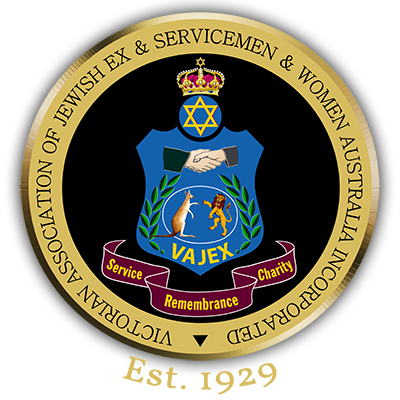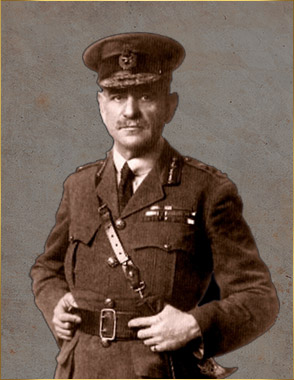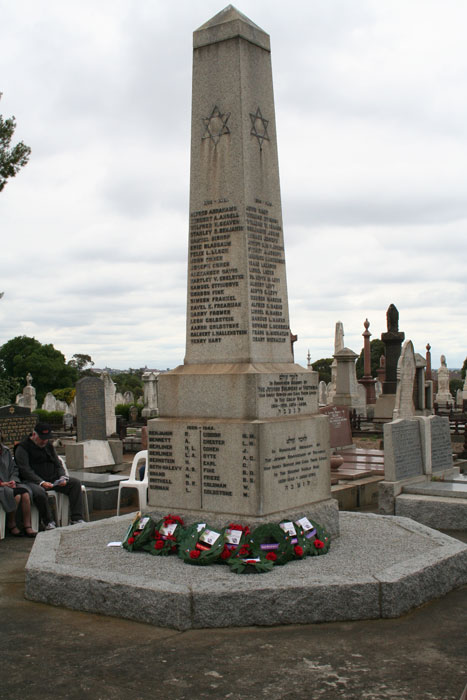Victorian Association of Jewish Ex & Servicemen & Women Australia Incorporated
Founding Member General Sir John Monash GCMG KCB VD
Nathan
Surname
Nathan
First names
Alfred (known as Matthew)
Rank
Private
Service No.
111 then 4909A
Date of Death
20/03/1917
Hebrew Date
26 Adar 5677
Hebrew Date
כ״ו בַּאֲדָר תרע״ז
Age at Death
22
How Died
Killed in Action
Where Died
France
Cemetery
Lebucquiere Communal Cemetery Extension, France
Service Details
60th Australian Infantry Battalion, AIF
Served
Western Front. WIA 19 July 1916 & 10 November 1916.
Occupation
Groom / Printer
Age at Enlistment
20
Place of Enlistment
Broadmeadows, Victoria
Locality on Enlistment
Religion
Jewish
Gender
Male
Date of Enlistment
26/10/1914
Date of Discharge
Country of Enlistment
Australia
Notes
Alfred (Abraham) Nathan was born in Aldgate, London in 1894. He was the eldest of the six sons of Michael NATHAN and Rachel née VALENCIA. In 1911, Alfred was working as printer in the Aldgate area but at some time between 1911 and 1914, Alfred immigrated to Australia, most likely taking up residence in NSW. With the outbreak of war, Alfred enlisted in the Army. On 26/10/1914 he attested at the Liverpool Camp and was given the regimental number 111. He gave his occupation as a Groom and was posted to 1 Australian Veterinary Section to undertake his military training. At the time of his enlistment, Alfred was described as 5ft 8 inches tall and weighing 11 stone. He had a dark completion, brown eyes and dark hair and gave his religion as Jewish. On 19/12/14 after barely 2 months training, Alfred embarked for Egypt on board the A31 HMTS “Ajana.” The ship docked in Port Said and on 30/1/15 Alfred found himself in trouble with the Army. Alfred was convicted of being AWL from the ship and was fined 10/- and given extra fatigues. The 1 Australian Veterinary Section disembarked and were sent by train to Cairo, then on to the main Australian camp at Mena. Here Alfred worked in the horse lines assisting with the care of the horses of the Australian Light Horse Regiments. Unfortunately, Alfred was to contract a disease and he was admitted to the Mena Isolation Hospital on 31/3/15. The practice was to return men to Australia to recover and so on 4/5/15 Alfred embarked on the A40 HMTS “Creamic” bound for Melbourne. He arrived back on 25/5/15 and was admitted to the Isolation Hospital at Langwarran. He was discharged on 9/8/15 and enjoyed some leave before reporting to the Broadmeadows Camp and was dispatched to the Light Horse Camp at Seymour on 9/10/15. What happens next is a mystery. Military records confirm he reported to the camp and was sent to the Staff Sargent of the Reinforcements section, he was seen to head off in that direction but there was no record of him ever being at the camp. Correspondence took place between various Army departments looking for him up until 17/12/15. At some point his records were stamped “Deserter” but this doesn’t appear to be the case and we can only assume that he was lost in the system. On the 1/3/16 Alfred re-attested at Broadmeadows, his previous enlistment papers could not be found at that time. He was assigned a new number 4909a. Alfred gave his occupation as a Printer and he was unmarried. He lists his mother, Rachel, as his next of kin. Five days later he married Alice Christina Lambert in Melbourne. When Alfred made his will, he left everything to his wife Alice. The following day he embarked on board the A18 HMTS “Wiltshire” with 8 Battalion 15 Reinforcements for Egypt. Further records indicate that he may also have left behind a child born out of wedlock, Victoria May Lambert. Alice unfortunately passed away in 1917. Military discipline did not sit well with Alfred and while at sea on board the HMTS “Wiltshire”, Alfred was charged with disobedience for breaking away from a route march. He received 72 days detention. On arrival in Alexandria, Alfred was once again taken by train to Cairo and the main Australian camp nestled below the pyramids at Mena. The AIF was being expanded and half the experienced men from 8 Battalion were merged with the newly arrived reinforcement to form 60 Battalion. Alfred was taken on to the strength of this new Battalion at Duntroon Plateau on 20/4/1916. For the next 2 months, he and the rest of the Battalion would undergo some very intensive training before they joined the BEF in France. On 18/6/16, the Battalion entrained for Alexandria where they embarked on the HMTS “Kinfauns Castle” bound for the battle fields of the Western Front. On 29/6/16 their ship docked in Marseilles. Once more they boarded a troop train and slowly headed for northern France and Flanders. After being issued with extra kit including Tin Helmets, 60 Battalion moved up into what was described as the “nursery” section near Fromelles. Arriving on 2 July they rested before moving up to the frontline trenches. On 19 July, they attacked the “Sugar Loaf”. They were slaughtered. The Battalion was virtually wiped out suffering 757 casualties. Amongst those casualties was Private Alfred Nathan. Alfred was hit in the face by either a shell fragment or bullet, its damaged his jaw, ears and neck. We have no information on how Alfred made it back to the allied trenches but on 24 July, 5 days after the assault, he was admitted to 13 Stationary Hospital and immediately sent to Boulogne then on to England by Hospital Ship “Cambria”. On 25 July, he was admitted to Middlesex War Hospital in Napsbury with bullet wounds to the face; here surgeons worked to repair the damage. On 15/9/16 Alfred was transferred to the Croydon War Hospital in St Albans to undergo further treatment, later on 22/11/16 he was again transferred this time to 3 Auxiliary Hospital to convalesce. On 9/12/16 he was discharged to furlough before reporting to Camp at Perham Downs. By the end of December, Alfred was once again in trouble. He was AWL, from 1 Command Depot from 21/12/16 to 28/12/16. Found guilty, he received 6 days Field Punishment No 2 and forfeited 14 days pay. On 4/2/17, he joined No 1 Command Depot and 3 days later on 5/2/17, proceed to France on board the SS “Invicta” from Folkstone. He marched in to 5 Division Camp at Etaples and on 10/2/17, a week later, he set out to re-join his unit catching up with them on 21/4/1917. His battalion was in the field, moving in and out of the trenches near Bapaume, they were under constant shell and machine gun fire throughout the following weeks, probing the German defences around “Switch Trench.” On 20 May, a push was made towards Delsaux Farm near Beugny, there were 3 soldiers killed and 14 wounded. Alfred was one of those who was killed in action during that attack. Alfred’s body was recovered and he now lies buried in Plot 11 Row G Grave 11 at Lebucquier Communal Cemetery Extension. The epitaph on his grave reads “Deeply mourned by his sorrowing parents and brothers”. For his service to our Nation, Alfred was awarded the 1914-15 Star, British War Medal and Victory Medal.

 John Monash (Monasch) born
in Melbourne, Australia on 27 June 1865, the son of
German Polish Jewish migrants, can be researched in any
military history encyclopaedia or in fact by just
‘Googling’ his name on the internet. His history
and list of achievements are long and far too many to detail
in this brief summary. However, might I say that reading his
history is well worth the effort and I can assure you that
his deeds will amaze you. I have found that the deeds are
better labelled on more than one man and in more than one
lifetime.
John Monash (Monasch) born
in Melbourne, Australia on 27 June 1865, the son of
German Polish Jewish migrants, can be researched in any
military history encyclopaedia or in fact by just
‘Googling’ his name on the internet. His history
and list of achievements are long and far too many to detail
in this brief summary. However, might I say that reading his
history is well worth the effort and I can assure you that
his deeds will amaze you. I have found that the deeds are
better labelled on more than one man and in more than one
lifetime. An
announcement was made in the weeks leading up to the
Centenary of ANZAC by Judy Landau, President VAJEX Aust.
She stated that it gave her great delight to announce
that VAJEX Aust (Victorian Association of Jewish Ex
& Servicemen & Women Australia Inc) has
successfully raised the required funds to build a new
Victorian Jewish Memorial after the style of the
historic Memorial located in the Jewish section of the
Melbourne General Cemetery. After an extensive two year
process, Judy has single-handedly sought letters of
support, raised the funds, and obtained approval from
the City of Port Phillip.
An
announcement was made in the weeks leading up to the
Centenary of ANZAC by Judy Landau, President VAJEX Aust.
She stated that it gave her great delight to announce
that VAJEX Aust (Victorian Association of Jewish Ex
& Servicemen & Women Australia Inc) has
successfully raised the required funds to build a new
Victorian Jewish Memorial after the style of the
historic Memorial located in the Jewish section of the
Melbourne General Cemetery. After an extensive two year
process, Judy has single-handedly sought letters of
support, raised the funds, and obtained approval from
the City of Port Phillip.

